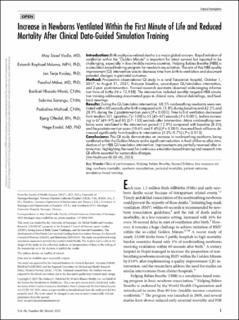| dc.contributor.author | Vadla, May Sissel | |
| dc.contributor.author | Mduma, Estomih | |
| dc.contributor.author | Kvaløy, Jan Terje | |
| dc.contributor.author | Mdoe, Paschal Francis | |
| dc.contributor.author | Hhando, Barikiel | |
| dc.contributor.author | Sarangu, Sabrina | |
| dc.contributor.author | Michael, Paskalina | |
| dc.contributor.author | Oftedal, Bjørg Synnøve Frøysland | |
| dc.contributor.author | Ersdal, Hege Langli | |
| dc.date.accessioned | 2023-10-25T08:08:34Z | |
| dc.date.available | 2023-10-25T08:08:34Z | |
| dc.date.created | 2023-10-11T09:58:30Z | |
| dc.date.issued | 2023-07 | |
| dc.identifier.citation | Vadla, M.S. Mduma, E.R., Kvaløy, J.T., Mdoe, P., Hhando, B., Sarangu, S., Michael, P., Oftedal, B.S.F. & Ersdal, H.L. (2023) Increase in Newborns Ventilated Within the First Minute of Life and Reduced Mortality After Clinical Data-Guided Simulation Training. | en_US |
| dc.identifier.issn | 1559-2332 | |
| dc.identifier.uri | https://hdl.handle.net/11250/3098584 | |
| dc.description.abstract | Introduction
Birth asphyxia–related deaths is a major global concern. Rapid initiation of ventilation within the “Golden Minute” is important for intact survival but reported to be challenging, especially in low-/middle-income countries. Helping Babies Breathe (HBB) is a simulation-based training program for newborn resuscitation. The aim of this HBB quality improvement (QI) intervention was to decrease time from birth to ventilation and document potential changes in perinatal outcomes.
Method
Prospective observational QI study in a rural Tanzanian hospital, October 1, 2017, to August 31, 2021, first-year baseline, second-year QI/simulation intervention, and 2-year postintervention. Trained research assistants observed wide-ranging information from all births (N = 12,938). The intervention included monthly targeted HBB simulation training addressing documented gaps in clinical care, clinical debriefings, and feedback meetings.
Results
During the QI/simulation intervention, 68.5% nonbreathing newborns were ventilated within 60 seconds after birth compared with 15.8% during baseline and 42.2% and 28.9% during the 2 postintervention years (P < 0.001). Time to first ventilation decreased from median 101 (quartiles 72–150) to 55 (45–67) seconds (P < 0.001), before increasing to 67 (49–97) and 85 (57–133) seconds after intervention. More nonbreathing newborns were ventilated in the intervention period (12.9%) compared with baseline (8.5%) and the postintervention years (10.6% and 9.4%) (P < 0.001). Assumed fresh stillborns decreased significantly from baseline to intervention (3.2%–0.7%) (P = 0.013).
Conclusions
This QI study demonstrates an increase in nonbreathing newborns being ventilated within the Golden Minute and a significant reduction in fresh stillborns after introduction of an HBB QI/simulation intervention. Improvements are partially reversed after intervention, highlighting the need for continuous simulation-based training and research into QI efforts essential for sustainable changes. | en_US |
| dc.language.iso | eng | en_US |
| dc.publisher | Wolters Kluwer Health, Inc. | en_US |
| dc.rights | Attribution-NonCommercial-NoDerivatives 4.0 Internasjonal | * |
| dc.rights.uri | http://creativecommons.org/licenses/by-nc-nd/4.0/deed.no | * |
| dc.subject | nyfødtgjenoppliving | en_US |
| dc.title | Increase in Newborns Ventilated Within the First Minute of Life and Reduced Mortality After Clinical Data-Guided Simulation Training | en_US |
| dc.type | Peer reviewed | en_US |
| dc.type | Journal article | en_US |
| dc.description.version | publishedVersion | en_US |
| dc.rights.holder | © 2023 The Author(s). | en_US |
| dc.subject.nsi | VDP::Medisinske Fag: 700::Klinisk medisinske fag: 750::Gynekologi og obstetrikk: 756 | en_US |
| dc.source.journal | Simulation in Healthcare: The Journal of the Society for Simulation in Healthcare | en_US |
| dc.identifier.doi | 10.1097/SIH.0000000000000740 | |
| dc.identifier.cristin | 2183602 | |
| cristin.ispublished | true | |
| cristin.fulltext | original | |
| cristin.qualitycode | 1 | |

